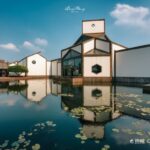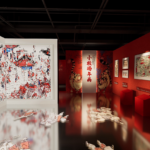The museum primarily features the distinctive local customs, folk culture, and everyday life and agricultural tools of Zhouzhuang. It also houses special exhibits such as chess and photography displays. The everyday utensils are a reflection of the life and labor in the water towns and rural areas, including bamboo baskets, fruit containers, and wedding essentials like the ‘quanpan’. There are also historical items like the juice-pressing stool and the standing bucket for children, which is akin to today’s baby walkers.
On the left side, one can find commonly used agricultural tools from the rural areas, such as windmills for winnowing grain, weeding tools, rice measuring implements, and plows for tilling the fields. The second room on the west side is dedicated to a chess exhibition, showcasing a variety of ancient and modern chess pieces, ranging from those weighing 12 kilograms to miniatures that require a magnifying glass to see clearly, as well as three-dimensional chess pieces. On the second floor, the museum珍藏s its treasures, including the Zhouzhuang Scroll—a panoramic view of the entire ancient town. This painting, 25 meters long and 0.9 meters wide, was completed by over 30 Chinese artists over the course of more than half a year. It integrates calligraphy, painting, and drawing, bringing the rich flavor of the water town to life once again. Also on display are the rock color paintings ‘A Day in Zhouzhuang’ by Japanese female artist Hashimoto Shinsen, as well as photographic works by photographers and enthusiasts from all over the country, and some unique handicrafts created by master craftsmen. Opening hours and specific business status are subject to the day’s opening conditions.Zhouzhuang Museum
The museum primarily features the distinctive local customs, folk culture, and everyday life and agr[...]









